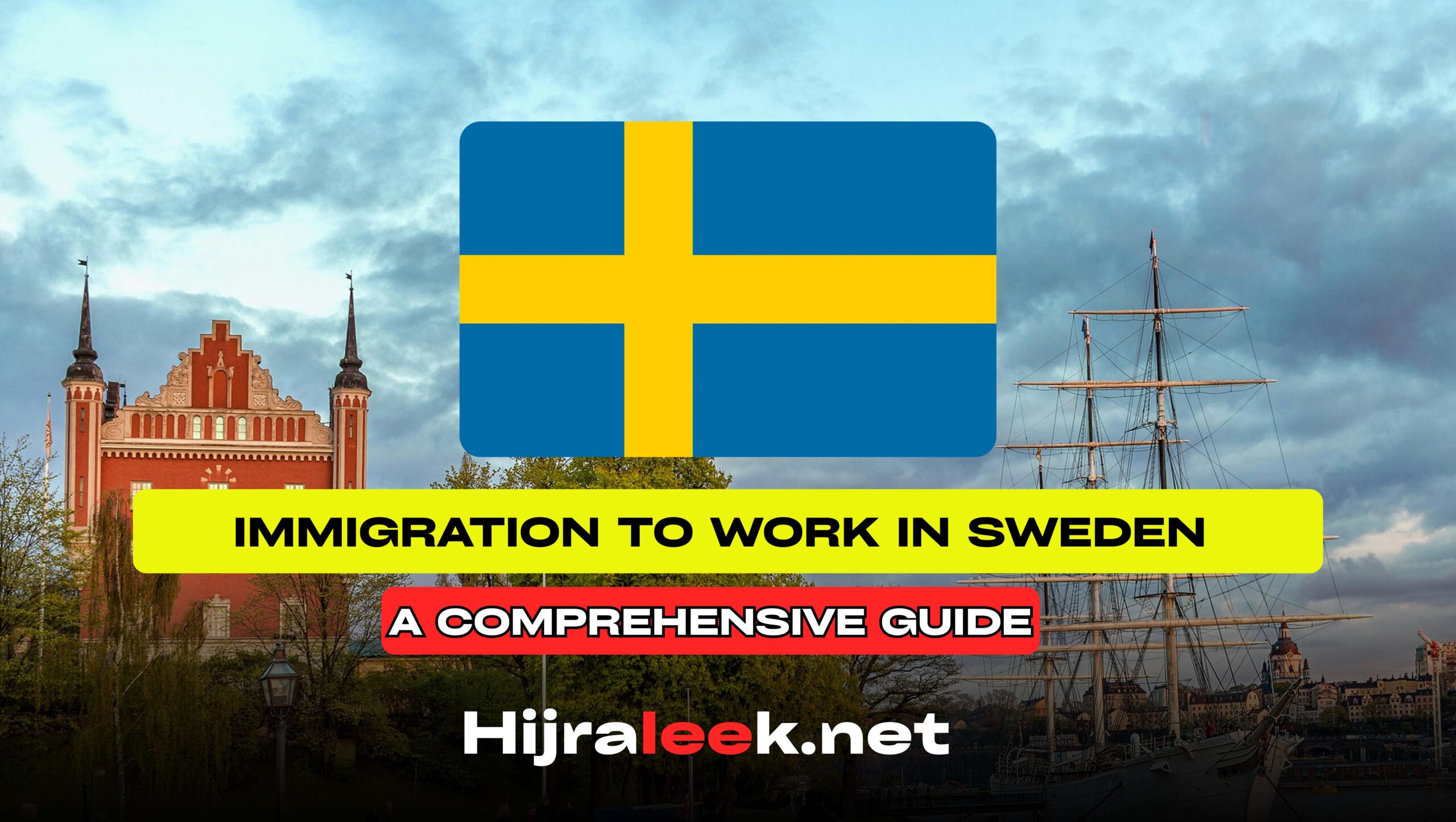Immigration to work in Sweden offers a remarkable opportunity for non-EU/EEA workers to join one of Europe’s most innovative and sustainable economies, renowned for its strong labor market in sectors like agriculture, technology, and healthcare. In 2026, Sweden continues to streamline its work permit processes to address labor shortages, with a focus on seasonal and skilled roles and a minimum salary threshold of SEK 27,360 per month for certain permits (effective since 2024, subject to updates). This comprehensive guide, centered on the keyword Immigration to Work in Sweden, details eligibility, required documents, the step-by-step application process, costs, salaries, benefits, challenges, and FAQs for securing work in Sweden in 2026. Platforms like Hijraleek connect workers with verified Swedish employers to simplify job searches, particularly for roles in agriculture, IT, and healthcare.
Introduction to Immigration to Work in Sweden
Sweden’s economy, contributing €600 billion to GDP annually, relies on a robust agricultural sector (e.g., berries, dairy), cutting-edge technology, and world-class healthcare. Immigration to work in Sweden is facilitated through work permits managed by the Swedish Migration Agency (Migrationsverket), targeting non-EU/EEA nationals. In 2026, Sweden expects to issue over 20,000 work permits, driven by a labor shortage of approximately 50,000 workers annually, particularly in seasonal agriculture and skilled professions. The work permit system, updated in 2024, emphasizes fair wages (minimum SEK 13,000/month for seasonal roles) and worker protections. Applications are submitted via the Migrationsverket online portal, with processing times of 1–4 months. Seasonal permits for agriculture (e.g., berry picking in Norrland) allow stays up to 6 months, while skilled roles offer pathways to longer residency.
Why Sweden is an Ideal Work Destination in 2026
Sweden boasts a high quality of life, with average salaries of SEK 35,000/month for skilled workers, 30 days of paid leave, and free public healthcare. Its commitment to sustainability drives demand in agriculture (e.g., organic farming), while tech hubs like Stockholm seek IT professionals. Updates in 2024–2026, including faster permit processing and relaxed rules for seasonal workers, make Sweden accessible for workers from Asia, Africa, and Latin America. Rural regions like Skåne and urban centers like Gothenburg offer diverse opportunities.
Who Can Apply for Immigration to Work in Sweden?
Immigration to work in Sweden is open to non-EU/EEA and non-Swiss nationals, as EU/EEA/Swiss citizens have free movement rights. Key eligibility criteria include:
- Nationality: Third-country nationals (e.g., India, Philippines, Brazil, Nigeria).
- Age: Minimum 18 years; no upper limit, but physical fitness is required for manual roles like berry picking.
- Job Offer: A signed contract from a Swedish employer, meeting minimum salary requirements (SEK 13,000/month for seasonal work; SEK 27,360/month for standard permits).
- Health and Character: Clean criminal record; medical clearance for stays over 3 months.
- No Formal Qualifications: Not required for seasonal roles; skilled roles need relevant education or experience.
Types of Work Permits for Sweden 2026
Sweden offers various work permits, tailored to seasonal and skilled employment.
Work Permit for Employed Persons
- Purpose: For long-term or permanent work in sectors like agriculture, tech, or healthcare.
- Duration: Up to 2 years, renewable; pathway to permanent residency after 4 years.
- Key Features: Requires a job offer, minimum salary of SEK 27,360/month (or industry-standard wage), and employer-provided insurance. Suitable for roles like farm supervisors or software engineers.
Seasonal Work Permit
- Purpose: For short-term work (up to 6 months) in agriculture (e.g., berry picking, vegetable harvesting) or tourism.
- Duration: 3–6 months within a 12-month period.
- Key Features: Lower salary threshold (SEK 13,000/month); no renewal within the same year. Ideal for summer harvests in Skåne.
EU Blue Card
- Purpose: For highly skilled professionals (e.g., IT specialists, doctors).
- Duration: Up to 2 years, renewable.
- Key Features: Minimum salary SEK 41,040/month; requires a university degree or 5 years of professional experience.
Eligibility Requirements for Immigration to Work in Sweden 2026
To qualify for Immigration to Work in Sweden, applicants must meet specific criteria aligned with Swedish labor laws.
Age and Health Conditions
- Age: 18 years or older; physical fitness is essential for labor-intensive roles like harvesting.
- Health: Medical certificate required for stays over 3 months or roles involving food/livestock safety (e.g., dairy farming). Tuberculosis screening may apply for high-risk countries, conducted by Migrationsverket-approved clinics.
Education and Skills Needed
- Education: No formal education required for seasonal roles (e.g., berry pickers; NOC equivalent 85103). Skilled roles (e.g., farm managers, IT professionals) need a degree or vocational training, verified by the employer.
- Skills: Relevant experience preferred; shortage occupations (listed on Migrationsverket) include agricultural workers and programmers.
Language Requirements
- Language Skills: No formal test (e.g., IELTS) required. Basic English or Swedish (A1 CEFR) is sufficient; English is widely used in urban workplaces, while rural farms may prefer basic Swedish.
Documents Required for Application
Prepare these documents, translated into English or Swedish and apostilled if needed.
Valid Passport and Photos
- Passport: Valid for 3+ months beyond stay, with 2 blank pages.
- Photos: Two recent biometric passport-sized photos (35mm x 45mm, white background).
Job Offer from a Swedish Employer
- Employment Contract: Signed, detailing role, salary (SEK 13,000+/month for seasonal; SEK 27,360+/month for standard), hours (up to 40/week), and benefits (e.g., insurance).
- Employer Confirmation: Proof of compliance with Swedish labor laws and union agreements; includes health, life, and pension insurance.
Medical Exam and Police Certificate
- Medical Exam: Certificate from an approved doctor (€100–€200), confirming no communicable diseases.
- Police Certificate: Criminal record check from home country and any country of residence for over 6 months in the past 5 years (€20–€100, apostilled).
Additional: Proof of accommodation (employer-provided or rental) and travel insurance (€30,000 coverage).
Step-by-Step Application Process for Immigration to Work in Sweden
The Immigration to Work in Sweden process takes 1–4 months; start in late 2025 for 2026 jobs.
How to Find a Job in Sweden 2026
- Job Search: Use Hijraleek, Arbetsförmedlingen, EURES, or LinkedIn for visa-sponsored jobs in Stockholm, Skåne, or Norrland.
- Contact Employers: Submit a CV highlighting relevant skills; interviews are typically virtual or phone-based.
- Secure Offer: Employer submits a job offer notification to Migrationsverket, ensuring compliance with salary and insurance requirements.
Peak seasons: June–September (berry picking, vegetable harvesting), year-round for skilled roles.
Online Application Process
- Obtain Job Offer: Secure a signed contract meeting salary thresholds.
- Gather Documents: Passport, photos, contract, medical/police certificates, insurance.
- Create Migrationsverket Account: Register at www.migrationsverket.se.
- Complete Form: Submit work permit application online; pay SEK 2,200 fee (standard) or SEK 1,100 (seasonal).
- Biometrics: Book an appointment at a Swedish embassy or VFS Global for fingerprints and photos (€85).
- Submit Application: Upload documents and track status via Migrationsverket portal.
Processing Time and Approval
- Processing Time: 1–2 months for seasonal permits; 2–4 months for standard permits.
- Approval: Receive a residence permit card (or visa sticker for short stays). Register with the Swedish Tax Agency (Skatteverket) upon arrival for a personal identity number.
Cost of Applying for Immigration to Work in Sweden 2026
Government Fees
- Work Permit Fee: SEK 2,200 (standard), SEK 1,100 (seasonal) for online applications; SEK 2,500/1,500 for paper submissions.
- Visa Fee: Included in permit for long-term stays; short-stay visa €80 if needed.
Other Expenses
- Medical Exam: €100–€200.
- Police Certificate: €20–€100.
- Travel: Flights €300–€800 (e.g., from Asia or Africa).
- Insurance: €100–€200 until public healthcare applies.
Total estimated cost: €600–€1,200, often offset by employer support or first paycheck.
Salary and Benefits for Workers in Sweden 2026
Average Salary in Sweden
- Low-Skill Roles: SEK 13,000–20,000/month (€1,200–€1,850; e.g., berry pickers, farmhands).
- Skilled Roles: SEK 35,000–50,000/month (€3,200–€4,600; e.g., IT specialists, nurses).
- Minimum Wage (2026): SEK 13,000/month for seasonal permits; industry-standard wages for skilled roles.
Housing, Food, and Transportation Support
- Housing: Employer-provided for seasonal workers (free or €200–€400/month); subsidized rentals in urban areas.
- Food: Often subsidized in rural farms; public canteens available.
- Transportation: Free work-related shuttles; discounted public transport with residence permit.
Additional benefits: 30 days paid leave, social security, and free healthcare/education for permit holders.
Challenges and Tips for Success
Common Challenges
- Salary Threshold: SEK 27,360/month for standard permits can be high for entry-level roles.
- Processing Delays: Up to 4 months during peak seasons.
- Language Barriers: Basic Swedish or English needed in rural areas.
- Cost of Living: High in Stockholm (€1,200/month for basics).
Tips for Fast Approval
- Apply Early: Start job searches in late 2025 via Hijraleek or EURES for 2026 roles.
- Verify Employer: Ensure they comply with Migrationsverket’s insurance and salary requirements.
- Complete Documents: Apostille and translate documents early to avoid rejections.
- Learn Basic Swedish: Free courses (e.g., Swedish for Immigrants) enhance employability.
- Track Application: Monitor status via Migrationsverket.
Useful Resources and Official Links
Swedish Migration Agency (Migrationsverket)
- Migrationsverket: Official site for work permit applications, forms, and updates.
Job Platforms for Work in Sweden
- Hijraleek: Connects workers with verified Swedish employers.
- Arbetsförmedlingen: Sweden’s public employment service.
- EURES: European job portal with Swedish listings.
- LinkedIn: Professional networking for skilled roles.
Conclusion
Immigration to work in Sweden in 2026 provides a pathway to a rewarding career in a country celebrated for its innovation, sustainability, and worker welfare. By securing a job offer through platforms like Hijraleek, preparing complete documentation, and applying via Migrationsverket, you can join Sweden’s workforce in agriculture, tech, or healthcare. With streamlined processes, higher wages, and growing demand, 2026 is an ideal year to start your Swedish journey.
Why 2026 is the Best Year to Apply
Sweden’s updated work permit system, expanded quotas, and focus on sustainable industries create abundant opportunities in 2026. Faster processing (1–2 months for seasonal roles), competitive salaries, and cultural attractions like Stockholm’s archipelago or Norrland’s northern lights make Sweden a top destination. Start today with Migrationsverket and Hijraleek to secure your Immigration to Work in Sweden.




















